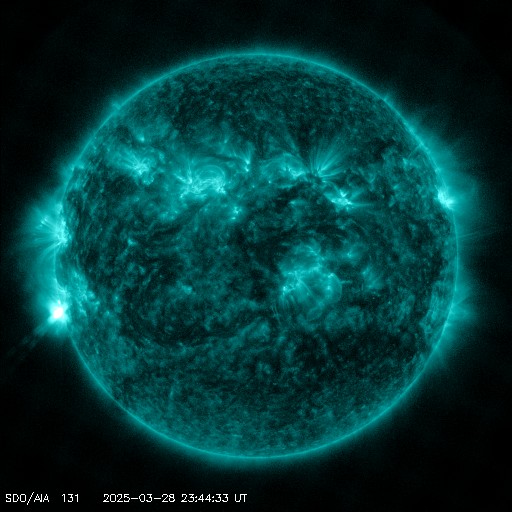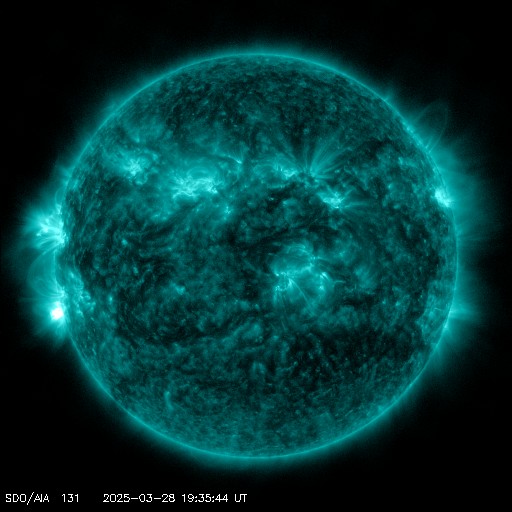Viewing archive of Friday, 20 June 2003
Solar activity report
Any mentioned solar flare in this report has a scaling factor applied by the Space Weather Prediction Center (SWPC). Because of the SWPC scaling factor, solar flares are reported as 42% smaller than for the science quality data. The scaling factor has been removed from our archived solar flare data to reflect the true physical units.
Report of Solar-Geophysical Activity 2003 Jun 20 2200 UTCPrepared by the NOAA © SWPC and processed by SpaceWeatherLive.com
Joint USAF/NOAA Report of Solar and Geophysical Activity
SDF Number 171 Issued at 2200Z on 20 Jun 2003IA. Analysis of Solar Active Regions and Activity from 19-2100Z to 20-2100Z
Solar activity increased to low levels today. Region
386 (S07E17) produced two low levels C-class flares today along with
several B-class flares. The northern portion of the penumbral field
appears to have undergone some rotation since yesterday while the
delta magnetic structure in the southern leading edge of group has
changed little during the period and remains intact. Region 387
(N18E36) was quiescent today although spot coverage and magnetic
complexity have both shown growth over the period. Region 389
(S12E14) was newly numbered today.
IB. Solar Activity Forecast
Solar activity is expected to range
from low to moderate levels. Region 386 remains capable of
producing an isolated major event.
IIA. Geophysical Activity Summary 19-2100Z to 20-2100Z
The geomagnetic field was at predominantly unsettled levels today as
effects from the western most recurrent coronal hole wanes. The
greater than 2 MeV electron flux at geosynchronous orbit reached
high levels today.
IIB. Geophysical Activity Forecast
The geomagnetic field is
expected to be at predominantly unsettled levels. Active conditions
may exist especially at high latitudes beginning late on day two
with the return of a recurrent coronal hole high speed stream.
III. Event Probabilities 21 Jun to 23 Jun
| Class M | 40% | 40% | 40% |
| Class X | 10% | 10% | 10% |
| Proton | 10% | 10% | 10% |
| PCAF | yellow | ||
IV. Penticton 10.7 cm Flux
Observed 20 Jun 117 Predicted 21 Jun-23 Jun 115/115/120 90 Day Mean 20 Jun 125
V. Geomagnetic A Indices
Observed Afr/Ap 19 Jun 016/018 Estimated Afr/Ap 20 Jun 010/015 Predicted Afr/Ap 21 Jun-23 Jun 010/015-012/015-012/020
VI. Geomagnetic Activity Probabilities 21 Jun to 23 Jun
| A. Middle Latitudes | |||
|---|---|---|---|
| Active | 15% | 25% | 25% |
| Minor storm | 05% | 05% | 10% |
| Major-severe storm | 01% | 01% | 01% |
| B. High Latitudes | |||
|---|---|---|---|
| Active | 30% | 30% | 40% |
| Minor storm | 15% | 15% | 20% |
| Major-severe storm | 05% | 05% | 05% |
All times in UTC
Current data suggests there is a slight possibility for aurora to appear at the following high latitude regions in the near future
Gillam, MB, Yellowknife, NTLatest news
Latest forum messages
AR4046 100Aurora photography hints for those of us with smartphones 48Large Coronal Hole 25 178Incoming & Unnumbered Active Regions 1655LASCO Data Not Updating 5
More topicsSupport SpaceWeatherLive.com!
A lot of people come to SpaceWeatherLive to follow the Sun's activity or if there is aurora to be seen, but with more traffic comes higher server costs. Consider a donation if you enjoy SpaceWeatherLive so we can keep the website online!

Latest alerts
00:00 UTC - Solar flare
Moderate M1.79 flare
Friday, 28 March 2025
23:36 UTC - Radio Blackout
Minor R1 radio blackout in progress (≥M1 - current: M1.04)
21:24 UTC - Hemispheric Power Index
The OVATION model predicts the Hemispheric Power Index to reach 51GW at 21:59 UTC
19:45 UTC - Solar flare
Moderate M1.16 flare
19:27 UTC - Radio Blackout
Minor R1 radio blackout in progress (≥M1 - current: M1.1)
Space weather facts
| Last X-flare | 2025/03/28 | X1.1 |
| Last M-flare | 2025/03/28 | M1.7 |
| Last geomagnetic storm | 2025/03/27 | Kp5 (G1) |
| Spotless days | |
|---|---|
| Last spotless day | 2022/06/08 |
| Monthly mean Sunspot Number | |
|---|---|
| February 2025 | 154.6 +17.6 |
| March 2025 | 128.3 -26.4 |
| Last 30 days | 128.3 -23.7 |




